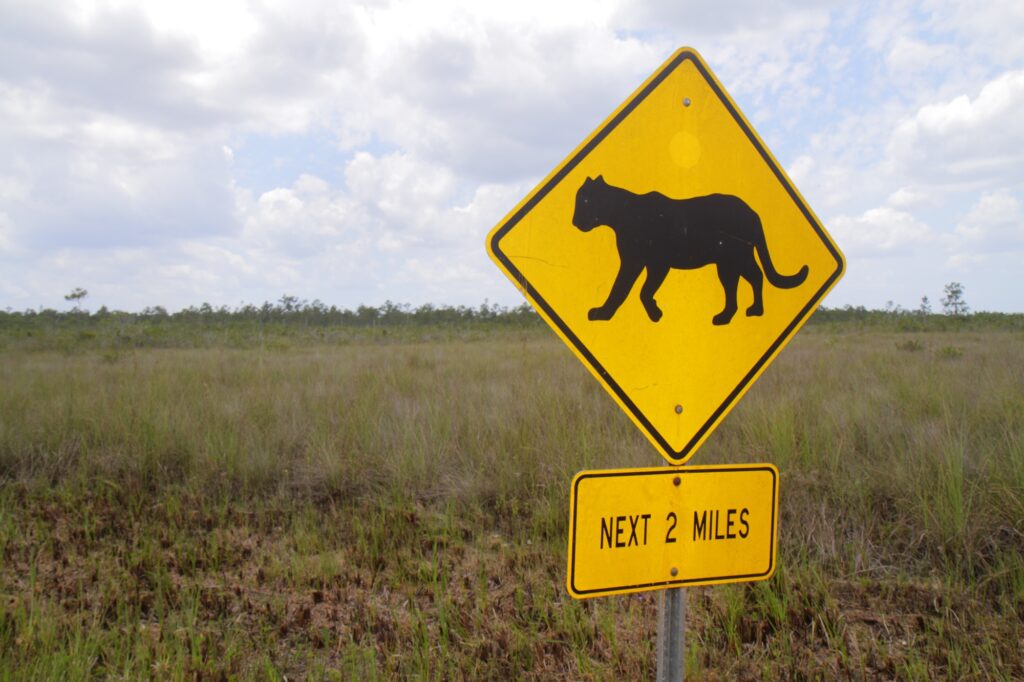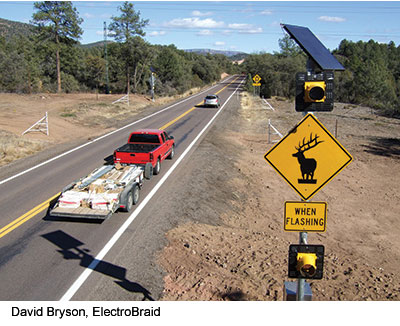“Until one has loved an animal a part of one’s soul remains unawakened.” Anatole France
MITIGATION OF WILDLIFE-VEHICLE COLLISIONS
Mitigation of wildlife-vehicle collisions takes many forms most notably wildlife crossing and wildlife corridors. Governmental agencies working in conjunction with NGOs have made significant progress in the areas of wildlife corridors and crossings. Nevertheless, as indicated in the Home page of this site, wildlife-vehicle collisions continue at staggering rates. The National Anti-Roadkill Project (NARP) aims to achieve mitigation of wildlife-vehicle collisions by deploying cost-effective – – but often neglected – – driver safety measures, as well as road safety measures.
Once NARP is operational, its initial campaign will address the loss of the critically endangered Florida panther to roadkill incidents. Roadkill is a leading cause of death for panthers. Consequently, it is imperative that driver and road safety strategies be utilized to help bring panthers back from the brink of extinction by mitigation of wildlife-vehicle collisions, which will significantly reduce avoidable fatalities.
Mitigation of Wildlife-Vehicle Collisions: Driver Safety Measures
Defensive driving for animals
Sudden encounters with wildlife on the road can be dangerous for both drivers and animals, whether these encounters are with large mammals passing through or with small creatures darting onto the street. Defensive driving for animals can literally be the difference between life and death by preventing avoidable wildlife-vehicle collisions.
Driver awareness programs
NARP intends to sponsor driver awareness programs that will spotlight the need for mitigation of wildlife-vehicle collisions. Such programs will seek to make drivers aware of the hazards that roads pose to wildlife and of the measures they can take to limit these dangers. By raising driver awareness of the risk of WVCs, drivers can learn to look through a new lens when they get behind the wheel of their vehicle. With increased awareness and a heightened degree of attention, drivers can be proactive in approaching the possibility that an animal may be on or near a road.
Quite simply, drivers must be conscious of animals when they drive. NARP’s driver safety campaign will underscore the need to drive defensively for the sake of animals (and humans too). The program will include safety tips to reduce avoidable WVCs, which can go a long way toward roadkill mitigation.
Driver education
Supplementing awareness with education about specific steps drivers can take will add another dimension to defensive driving for wildlife. To promote responsible driving for wildlife, NARP plans to collaborate with DMVs, by advocating for a licensing requirement by which drivers must take a program that teaches these skills. NARP will develop a curriculum for DMVs that can be used in driver education courses.
In the area of education, NARP also plans to produce television and radio public-service announcements, print brochures, fliers and bumper stickers. The organization will also promote study modules that can be included in high school driver-education courses, as well as in professional driving school classes.
Public service announcements
Public service announcements broadcast via radio, television, and internet will be used to teach drivers precautions they can take to effect mitigation of wildlife-vehicle collisions. PSAs can draw attention to the staggering toll that our roads take on wildlife and include defensive driving tips such as: reducing speed; scanning the road; blowing horns and flashing headlights when an animal is in sight (particularly critical for deer which instinctively reacts by freezing when an approaching vehicle has headlights on); avoiding sudden vehicle movements when an animal is spotted on a road or its shoulder; and being especially vigilant when driving in areas where wildlife is abundant. NARP will employ print materials such as bumper stickers and brochures to spread the word about defensive driving for wildlife and specific driving skills that can help spare countless animals from agonizing deaths and debilitating injuries on our roads.
Florida panther driver safety measures
Driver safety measures of NARP’s Florida panther initiative will include:
- Raising awareness that panthers may be on or near a road when driving in their habitat, and urging drivers to vigilantly scan both sides of the road for these endangered cats.
- Imploring the Florida Highway Safety and Motor Vehicles (FLHSMV) to require driver’s license applicants to take a defensive driving for wildlife program that emphasizes the toll of WVCs on the Florida panther.
- Imploring FLHSMV to require driver’s license applicants to take a defensive driving for wildlife program that emphasizes the toll of WVCs on the Florida panther.
- Imploring FLHSMV to include in their study manual for driver license applicants a section devoted to defensive driving for wildlife (with an emphasis on panthers).
- Urging Floridian driver training schools to include in their curricula lessons for defensive driving for wildlife (with an emphasis on panthers).
- PSAs informing drivers to be mindful of panthers that may cross on roads, with helpful reminders of what can be done to avoid WVCs when driving in panther habitat.
Mitigation of Wildlife-Vehicle Collisions: Road Safety Measures
Speed kills!
Road safety measures to protect animals from being stricken by vehicles start with instituting speed limits that are commensurate with threats posed to wildlife. NARP intends to advocate for traffic officials to reduce speed limits in areas where animals are likely to cross. NARP will also advocate for implementation of traffic calming measures on select roads to deter drivers from exceeding speed limits.

Traffic violation penalties
Another critical component of NARP’s initiative is to put muscle behind speed limits and other traffic violations that put wildlife at risk. NARP will seek for authorities to institute meaningful disciplinary action in the form of substantial fines and/or other severe penalties (e.g., revocation or suspension of license) for traffic infractions that endanger wildlife. This will send a clear message to drivers that such conduct will not be tolerated. NARP will also advocate for the implementation of legislation to make drivers who engage in such conduct subject to criminal prosecution.
Wildlife crossing signs

As part of a multi-dimensional plan to tackle the roadkill issue, NARP intends to champion installation of strategically placed wildlife crossing signs on roads in or near wildlife habitat. These signs have been proven to be effective by alerting drivers to take special precautionary steps to avoid WVCs.
Emergency treatment centers
In due course, NARP will explore the feasibility of establishing 24-hour centers where injured wild animals can receive emergency treatment and rehabilitation. NARP will also seek to develop an innovative text alert system for a network of wildlife rehabilitators, enabling them to provide care for injured wild animals and/or to rescue helpless orphans whose mothers are taken by WVCs.
Road ecology
Road safety measures are within the field of road ecology, which is the study of the ecological effects of roads and highways. This field includes the design, construction and management of roads, including wildlife crossings that allow animals to safely cross human-made barriers such as roads.
Ideally, all new highways and roads should incorporate animal welfare and habitat-fragmentation considerations as legitimate design questions. However, while wildlife overpasses and underpasses, as well as wildlife corridors, are highly effective, their considerable cost of construction and/or exceedingly lengthy time-consuming red-tape delays, oftentimes makes these infrastructure projects prohibitive to develop.
Further, wildlife crossings, by their very nature, have countless miles between these structures that leave animals vulnerable to the ever-present danger of vehicular traffic. NARP will fill that void with its cost-effective program of driver and road safety measures which would complement to those projects. Though NARP will not focus on infrastructure projects, it will encourage and assist local, state, and federal officials to consider wildlife in the design and maintenance of roads, as part of its road safety program.
Florida panther road safety measures

Road safety measures that NARP aims to promote for its Florida panther roadkill mitigation initiative include:
- Designated panther protection zones that will be armed with special traffic rules pertaining to vehicular threats to the safety of panthers.
- Special provisions for criminal prosecution, with severe penalties for any driver who commits an infraction that causes or is likely to cause panther injury or death, in panther protection zones.
- Urging traffic officials to ramp-up patrols to be on the look-out for drivers that commit violations that endanger panthers as part of a zero-tolerance policy in panther protection zones.
- Strict speed limits commensurate with the WVC threat posed to panthers in panther protection zones.
- Strategically placed panther crossing signs warning drivers when the road they are on near a panther protection zone.
- Roadway lighting appropriate for the conditions on roads in panther protection zones.
- Deploying science-based technological innovations, such as Roadside Animal Detection Systems (RADS), that offer the potential to protect animals from being stricken by cars.
- Lobbying legislators to permit license plate recognition cameras to be utilized by police, on highways or roads that run through panther habitat, to ticket vehicles that are in violation of speed limits or other traffic infractions that endanger panthers.
ACTION PLAN
NARP’s wildlife-vehicle mitigation plan of driver safety and road safety measures are a necessary accompaniment to corridors and crossings. The solution requires a far-reaching approach that will address “hot spots” in roads where corridors and crossings do not provide safe passage for wildlife yet is a likely crossing point for a substantial number of animals.
NARP intends to work with governmental wildlife services, departments of transportation, legislative bodies, law enforcement and NGOs to minimize WVCs. The focal point of NARP’s pursuit of roadkill mitigation will be a hard-hitting call to action primarily directed at drivers to be mindful of the welfare of wildlife that our forced to cross roads for their survival. NARP’s plan of action can, and will, make a consequential difference in the life-threatening dilemma that wildlife is confronted with by our 4-million-mile public road network.
In adopting these measures, Americans will not only regain some of their lost fellowship with wildlife, but they will also hasten the day when the freedom to drive someplace will not automatically imply the high probability of depriving countless innocent animals of their lives.




